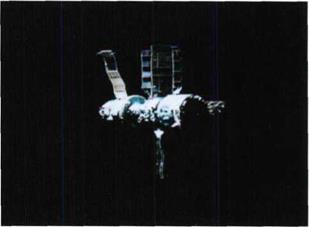

The Soyuz transport spacecraft (of 7K-T type) docked to the Salyut station.

|
The first longterm orbital station (DOS – 7K had only one docking assembly.
|
|
Crew, men 3
Orbital module flight time, days, no more than 90
Total autonomous flight time for transport spacecraft, days, no more than 3
Total flight time transport vehicle, days, no more than
As part of DOS-7K #1, 2 30
As part of DOS-7K#3. 4 cn
Orbital parameters
Inclination 51.6U±5‘
Initial orbit for orbital module
Perigee 220±4,5
apogee 260±11
Orbit of orbital module
After ascent, KM 255
Assembly orbit, KM 190-220
Thrust, KGF
Primary engine 417H5
Backup engine 411 ±25
Length, M
Orbital module 16
Orbital station 23
Maximum diameter orbital module, M 4,15
Total mass station after docking. KG 24 900
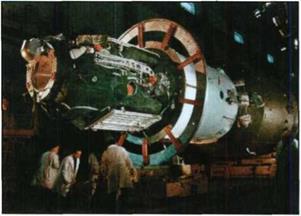 Mass scientific research instruments and equipment, KG, no more than 1500
Mass scientific research instruments and equipment, KG, no more than 1500
The Salyut orbital station on the mounting bogie.
|
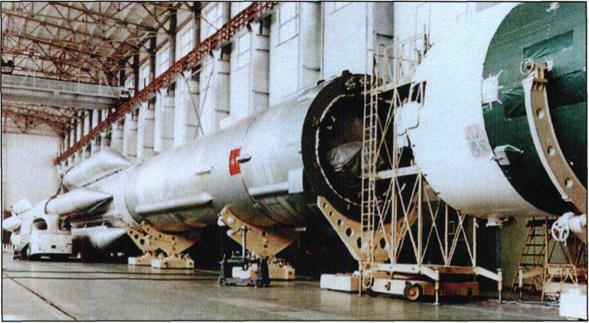
Preparation of the orbital station for mating with the Proton launch vehicle.
|
|
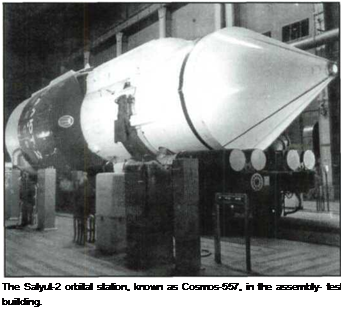
 The Proton launch vehicle with the first Zarya orbital station, which was called Salyut in the press, on the launch pad.
The Proton launch vehicle with the first Zarya orbital station, which was called Salyut in the press, on the launch pad.
|

The Salyut-4 orbital station on the mounting bogie.
|
|
|
The Salyut-4 orbital station.
|
|

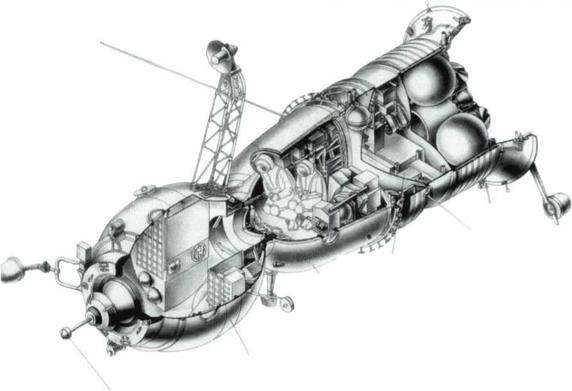

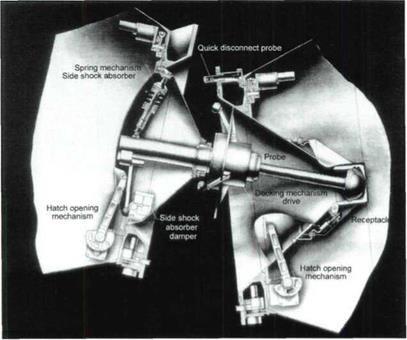 Orbital parameters,
Orbital parameters,
altitude. KM inclination, penod, min
The Soyuz-type transport spacecraft (7K-T) used to supply the first generation orbital stations.
The Soyuz-IO spacecraft (7K-T) and subsequent craft had docking assemblies with a central transfer hatch through which cosmonauts could transfer from one spacecraft to the other without egressing into space.
|

The Soyuz type spacecraft in its assembly jig.
|
|
Emergency Descent System Operating Sequence During Ascent
|
|
|
|
|
|
|
Backup parachute system activation
|
|
 |
 |
 |
 |
|
The Soyuz descent vehicle landing. The descent vehicle was about 3 tons in mass, and 2.2 meters in diameter (over thermal protection). Its configuration is similar to a "head-light" (the lift-to-drag ratio was 0.30).
|
|
|
The Soyuz T spacecraft descent vehicle at the landing site.
|
|
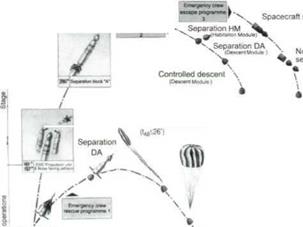
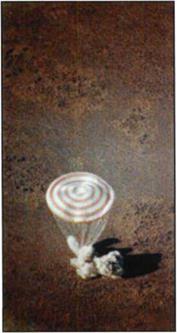


|
Operation of the Soyuz spacecraft landing complex.
|
|
|
Descent on primary parachute system
|
|
|
Eject cover, deploy braking parachute
|
|
|
Descent on braking parachute
|
|
|
Discard braking parachute and deploy main parachute
|
|
|
Descent on reefed main parachute
|
|
|
Discard frontal heat shield
|
|
|
Prelanding operations descent on main parachute
|
|
|
Fire soft landing engines
|
|
|
Landing, release chute cords
|
|
|
Descent on reserve parachute system
|
|
|
|
 |
|
Descent on reefed reserve parachute
|
|
|
Discard of frontal heat shield
|
|
|
Prelanding operations. descent on reserve parachute
|
|
|
|
|
Fire soft landing engines
|
|
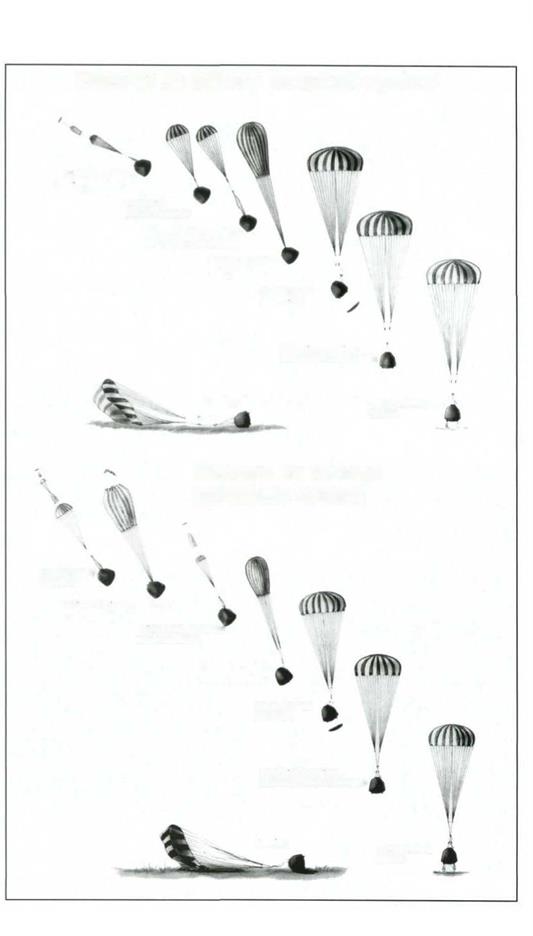

|
Stages of the Salyut orbital station development
|
|
|
The Salyut-6 orbital station (second generation station) had two docking assemblies to which the transport and cargo spacecraft could be docked.
|
|
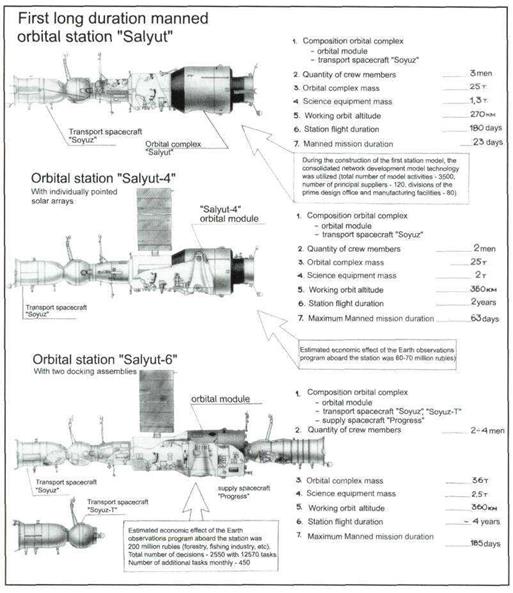

 |
|
|
|
|
|
|
|
Crew. men.
|
2-4
|
|
Orbital flight time, days no more than
|
180
|
|
Overall manned flight time with life support resources for two crew men, days
|
95-110
|
|
Flight time of one transport spacecraft attached to station. days
|
5-60
|
|
Orbital parameters attitude. KM
|
350
|
|
inclination.
|
51.6
|
|
Attitude precision.
orbital system coordinates
|
-30-50
|
|
inertial system coordinates (utilizing AO-1 or S-2)
|
-10-20
|
|
|
|
Solar array average daily capacity (dependant on position in orbit and station attitude ) KW
|
1-3
|
|
Length orbital station (with 2 spacecraft). M
|
28,55
|
|
Maximum diameter of the station orbital module. M
|
4.15
|
|
Total mass station
(after docking with 2 spacecraft). T
|
-32
|
|
Mass of research and experiment equipment, T no more than
|
2.5
|
|
Transport spacecraft:
for docking from transfer compartment side
|
N*39,40
|
|
for docking from propulsion module side
|
N■41,42
|
|
|
|
Scope of work on orbital module
1 Propulsion module manufacturing with docking assembly and peripheral propulsion unit
based on article 11F32
2 Installation of additional set of "IGLA" antennas
3 Addition of secondary docking system control module
|
|
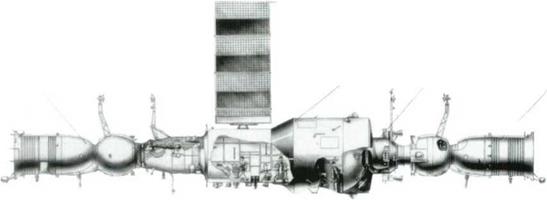
The Salyut-6 orbital station (second generation station) had two docking assemblies to which the transport and cargo spacecraft could be docked.
The Salyut-6 orbital station with the docked SoyuzT spacecraft in flight..
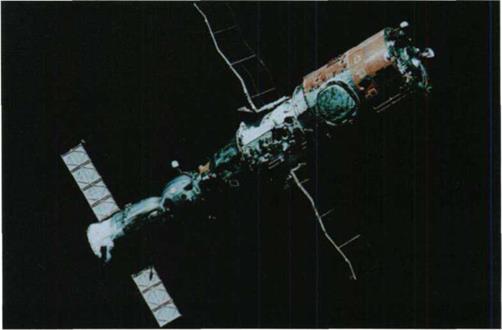
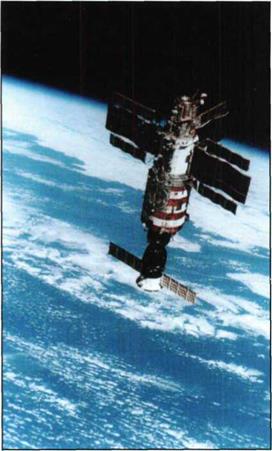 The Salyut-7 orbital station with the docked SoyuzT spacecraft in flight.
The Salyut-7 orbital station with the docked SoyuzT spacecraft in flight.
The Salyut-7 orbital station with the Cosmos-686 cargo spacecraft in automatic flight mode.
|
The Soyuz T transport spacecraft with solar arrays.
|
|
 |
|
|
|
|

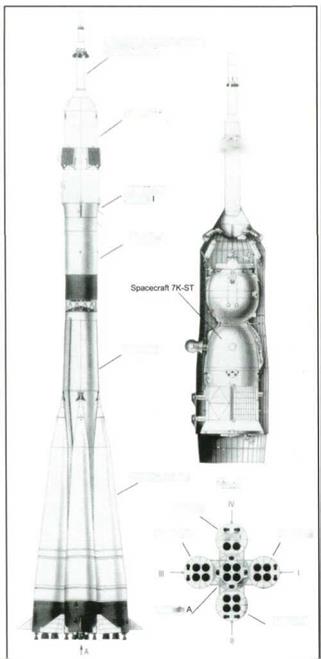 The I I AS 11Y launch vehicle with the 7K.-ST (SoyuzT) spacecraft.
The I I AS 11Y launch vehicle with the 7K.-ST (SoyuzT) spacecraft.
 |
|
|
 |
|
|
|
|
|
Launch vehicle
|
11А511У
|
11А511У-2
|
|
Initial orbital parameters:
|
|
|
|
|
inclination, …*
|
51.6
|
|
64.8
|
|
altitude (average). KM
|
|
220
|
|
|
Lift-off mass, T:
|
|
|
|
|
carrier stage and nose fairing with payload
|
3097
|
|
ЗЮ.0
|
|
spacecraft
|
6.855
|
|
6 740
|
|
Crew, men
|
2-3
|
|
2-3
|
|
Number stages on launch vehicle
|
|
3
|
|
|
Stage 1
|
module A. B.V. G.D
|
|
|
Stage 2
|
|
module A
|
|
|
Stage 3
|
|
module 1
|
|
|
Fuel component
|
|
|
|
|
module A
|
oxygen
|
♦ oxygen t
|
|
kerosene
|
|
cycline
|
|
module B. V.G. D,I
|
oxygen ♦ kerosene
|
|
Maximum engine thrust TC
|
|
|
|
|
Stage 1
|
|
|
|
|
on Earth
|
413.3
|
|
420 0
|
|
in vacuum
|
505.3
|
|
509 5
|
|
Stage 2 – in vacuum
|
99.7
|
|
103.1
|
|
Stage 3 – in vacuum
|
|
30.4
|
|
|
Length of launch vehicle and
|
|
|
|
|
nose fairing with payload
|
51.1
|
|
51.3
|
|
Maximum transverse dimensions. M
|
|
10.3
|
|
|
|
|
|
|
|
|
|
|
|
|
|
|
|
|
|
|
 |


|
The launch vehicle with the Progress spacecraft.
|
|
|
The Progress cargo spacecraft.
|
|
|
Mass spacecraft. KM 7020
Delivered payload weight. KG -2300
including:
in cargo module. KG. not more than 1300 in propellant module, KG not more than 1000
Maximum length. M 7,94
Maximum diameter
pressurized module. M 22
Launch vehicle "Soyuz“
Flight time. days, not more than:
autonomous 3
with orbital station 30
Orbital parameters
altitude. KM 200-350
inclination. 51.6
period, min
|
|
 |
 |
|
|
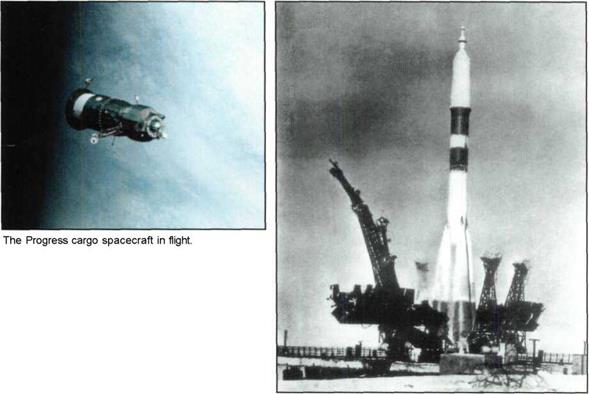
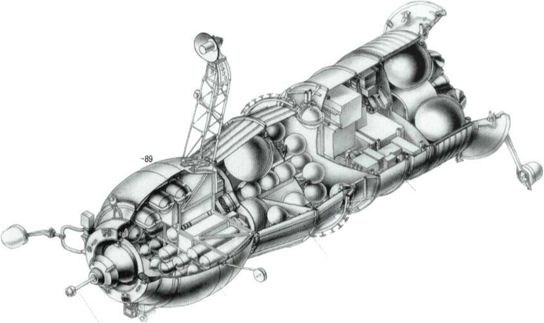
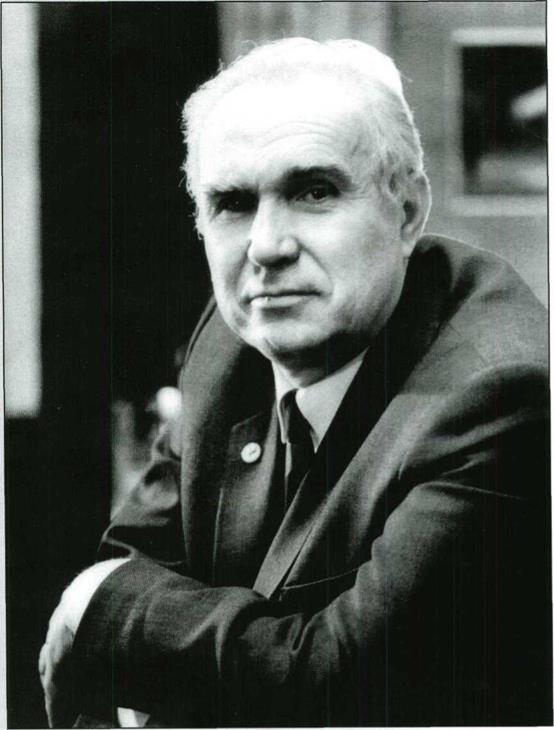
Yuri Pavlovich Semenov
General Director and General Designer of S. P. Korolev NPO Energia since 1989
![]()

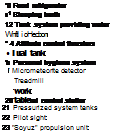


 Mass scientific research instruments and equipment, KG, no more than 1500
Mass scientific research instruments and equipment, KG, no more than 1500
 The Proton launch vehicle with the first Zarya orbital station, which was called Salyut in the press, on the launch pad.
The Proton launch vehicle with the first Zarya orbital station, which was called Salyut in the press, on the launch pad.
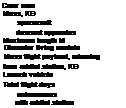

![]()
 Orbital parameters,
Orbital parameters,











 The Salyut-7 orbital station with the docked SoyuzT spacecraft in flight.
The Salyut-7 orbital station with the docked SoyuzT spacecraft in flight.

 The I I AS 11Y launch vehicle with the 7K.-ST (SoyuzT) spacecraft.
The I I AS 11Y launch vehicle with the 7K.-ST (SoyuzT) spacecraft.


















